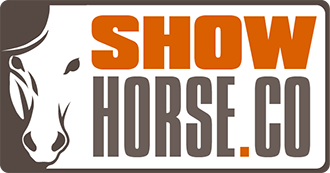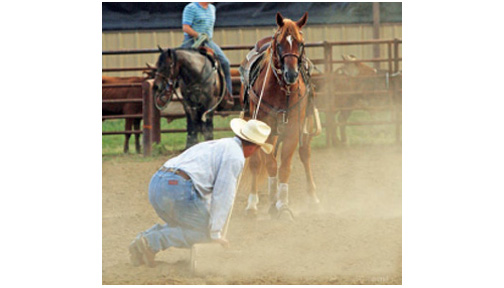Hey, Kid, Slow Down
April 9, 2013
Want to work on rope-horse training? Take your time and focus on fundamentals.
Everybody’s scared to slow down, but sometimes slowing down is the easiest way to be faster. Journal photo.
By AQHA Professional Horseman Mark Wray with Christine Hamilton in The American Quarter Horse Journal
The basic fundamentals of ropingare simple – your horse scores good, he stands flat-footed, the gate bangs, you drop your hand, and your horse runs to the cow. That all sets in motion your next steps – stand up, swing the rope, deliver, catch and handle.
If any of those steps get out of whack, chances are you’re going to have to hustle somewhere else because you have to compensate for it. All the steps go together.
And then you add speed, and it’s probably your worst enemy, whether you’re an older rider or a younger one.
If you always come out of the box throwing as fast as you can, your horse will probably let you do it for a little while, but then all of a sudden, he might just take yourdally away. The more you reach and the quicker you go, the faster your horse is going to try to get ahead of you and anticipate you. Most horses will try to find an easier way to do something. If they think they can cut across the corner, they will. As some point, you’re going to have to slow down and rope and keep your horse honest.
If you get into a speed jam and suddenly you’re having a hard time catching, slow down, clear your mind and go back to basics. Work on catching them all, but you don’t have to be quick about it, you just have to be correct.
Everybody’s scared to slow down, but sometimes slowing down is the easiest way to be faster.
Are you thinking that you need to go back to the basics of roping? Or are you brand new to roping and want to learn the fundamentals? If so, then the AQHA FREE “Roping Basics” report is for you. AQHA Professional Horseman Patrick Hooks of Texhoma, Oklahoma, says that roping just requires knowledge and lots of practice, no magic required!
Think “Horsemanship”
If things start to go wrong – say your horse is getting quick on you in the heading or wanting to stop too short in the tie-down – it takes a lot of discipline on your part to go, “OK, I’m done. I’ve got to stop now and worry about my horsemanship first,” becausehorsemanship is often something ropers are willing to give up.
That’s one thing I like about getting youth in AQHYA – there’s nothing wrong with someone judging your performance on your rope horse.
You can get by doing it any which way you want, but roping in AQHYA teaches the correct ways that will make you get better and make your horse better. There are a lot of people out there who rope really well, and their horsemanship gets put by the wayside, but just think how much better they would be if they focused on the horse a little more.
It all goes back to horsemanship. You have to have the patience to slow down in the corner or score if your horse needs it, or slow down and think about not bringing yourrope up before you leave the box – slow down and smooth those parts out.
Here are some common problems where working on your horsemanship can help.
Leaning Too Much
Generally two things make people lean forward too much.
They might feel like they’re not getting to the cow – either their horse can’t run or he’s slowing up underneath them.
But if you lean out over the top of your horse, he will stop running underneath you. People who get up and over the top of their horse slow the horse up.
If your horse really can’t run, you better sit up on him square to help that horse move underneath you. Get better posture in the saddle to help your horse more, if he needs help.
In AQHA’s “Roping Basics” FREE report, Patrick Hooks starts by introducing the terminology of roping and the different types of ropes available. With his step-by-step instructions, Pat will show you how to build a loop and swing a rope. With enough practice, you’ll be able to rope anything, from cattle to your kitchen chair!
When some ropers are running up close, they want to lean down and lay the loop on the cow. What they end up doing most of the time is laying it right beside the animal.
It’s all about posture. When you change the angle of your body, you change the angles of your rope, too.
You need good posture where you’re sitting square in the saddle. You are going to come forward – there’s forward momentum when your horse travels forward, and you’ve got to overcome that balance – but you do need to sit square and stay in the middle of your horse.
Dropping Your Elbow
If you drop your elbow, you take away any chance of getting your loop to the cow. When your elbow stays down to your side, it’s hard to get enough forward power to get the rope to your target. In tie-down roping, the loop will go down the calf’s right shoulder, or in heeling, you’ll lay it right beside the steer.
By raising your elbow, that’s where a lot of your power comes from. Your forearm throws your loop out across the cow and gives the loop momentum and a place to go.
I tell ropers to think about putting the plane of their loop across the horns.
For example, in tie-down roping, you often see it first take shape like a right-angled plane, where the rope goes down at the calf and comes around the neck more. When you raise your elbow, the plane will come across the horns, and you’ll see the rope pulled across the cow’s back more.
That’s where the roping dummy comes in handy – you can take the time to fix it or figure it out at your own pace and skill level.
High Left Hand
Be aware of where your left hand is – that goes along with horsemanship. It doesn’t follow very good logic to be on your approach to a cow and pulling on your horse all the way there, but it’s pretty common.
If you drop your hand, most horses will rate a cow. But if you’re pulling, they’re going to pull back, and they will step back. Stay out of their way as much as you can.
With all the tips and helpful instructions in AQHA’s FREE “Roping Basics” report, you’ll be ready to compete in AQHA’s Versatility Ranch Horse competition in no time! Or if you’re more interested in just learning the skill of roping, you’ll be able to impress your friends by practicing your loop building ability on them.
Work the Dummy
You’ll find out what makes you tick on the roping dummy; don’t be scared to spend time practicing on it. When you’re on the dummy, you’ll figure out where your high percentage shot comes from. And if you have some bad habits, that’s the easiest place to correct yourself.
Give Your Horse a Break
A lot of people don’t get to rope every day, so they think they’ve got to rope as manysteers or calves as they can when they rope. But you have to be conscientious of your horse, and give him a break and keep him happy.
Some horses are good-natured enough that riders can run as many as they want to and the horse just takes it and goes along – but those are very rare. If your horse is happy, he’s more willing to do his job, especially if he’s a nice horse.
There’s no way that you can be as sharp at the end of 25 steers as you were in the first five. Why did you start roping poorly, or why did your horse start cheating on you? Well, maybe your horse got tired or you got tired.
End your session on a positive note where you can feel good about yourself and your horse.
Check out this winning run from the 2012 AQHA Senior Tie-Down Roping World Champion!


